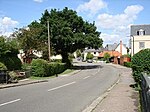Little Leighs
City of ChelmsfordEssex geography stubsFormer civil parishes in EssexVillages in Essex

Little Leighs is a village and former civil parish, now in the parish of Great and Little Leighs, in the Chelmsford district in the English county of Essex. In 1931 the parish had a population of 158. On 1 April 1949 the parish was abolished and merged with Great Leighs to form "Great and Little Leighs".Little Leighs lies beside the River Ter, just south of the village of Great Leighs. Until rerouting bypassed the village, Little Leighs was on the A131 road. The church in the village is dedicated to St John the Evangelist. Built of flint rubble, the fabric of the structure dates back at least as far as the early twelfth century.
Excerpt from the Wikipedia article Little Leighs (License: CC BY-SA 3.0, Authors, Images).Little Leighs
Church Lane, Chelmsford Great and Little Leighs
Geographical coordinates (GPS) Address Nearby Places Show on map
Geographical coordinates (GPS)
| Latitude | Longitude |
|---|---|
| N 51.8235 ° | E 0.4926 ° |
Address
Church Lane
Church Lane
CM3 1PG Chelmsford, Great and Little Leighs
England, United Kingdom
Open on Google Maps







